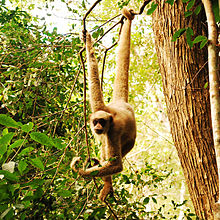Muriqui
The muriquis, or woolly spider monkeys, are the genus Brachyteles.[1] There are two species, the southern (B. arachnoides) and northern muriqui (B. hypoxanthus) muriquis. The name "muriqui" comes from a native Tupi word meaning 'largest monkey'.
| Muriquis[1] | |
|---|---|

| |
| Northern muriqui, Brachyteles hypoxanthus | |
| Scientific classification | |
| Domain: | Eukaryota |
| Kingdom: | Animalia |
| Phylum: | Chordata |
| Class: | Mammalia |
| Order: | Primates |
| Suborder: | Haplorhini |
| Infraorder: | Simiiformes |
| Family: | Atelidae |
| Subfamily: | Atelinae |
| Genus: | Brachyteles Spix, 1823 |
| Type species | |
| Brachyteles arachnoides É. Geoffroy, 1806
| |
| Species | |
They are the two largest New World monkeys. The northern muriqui is one of the most endangered monkeys in the world.[2] They are seen only in some forests in Brazil.
The adult muriqui is 15-23 inches (38–58 cm) long and weighs from 10-20 pounds (4.5-9 kilos) They are colored from brown to black and the bottom of their tails have no fur near the end.
Muriquis live in groups from four to 43. They do not fight about their territory. They mostly eat leaves. They sometimes eat fruit and flowers in the rainy season, as well as bark, bamboo, ferns, nectar, pollen, and seeds.
References
change- ↑ 1.0 1.1 Groves C.P. 2005.
- ↑ Chaves, Paulo B.; et al. (2011). "Genetic diversity and population history of a critically endangered primate, the northern muriqui (Brachyteles hypoxanthus)". PLOS ONE. 6 (6): e20722. Bibcode:2011PLoSO...620722C. doi:10.1371/journal.pone.0020722. PMC 3108597. PMID 21694757.
Further reading
change- Mittermeier, Russell A. (March 1987). "Monkey in peril". National Geographic. 171 (3): 387–395. ISSN 0027-9358. OCLC 643483454.
Other websites
change- Conservation of the Muriqui from Brazil Archived 2015-09-24 at the Wayback Machine
- Southern muriqui at ARKive Archived 2013-05-13 at the Wayback Machine
- Northern muriqui at ARKive Archived 2013-08-01 at the Wayback Machine
- Primate Info Net Brachyteles Factsheet
- Southern Muriqui Home Page Archived 2021-05-06 at the Wayback Machine - Pró- Muriqui Association